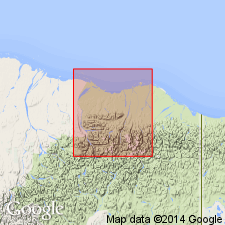
- Usage in publication:
-
- Sadlerochit sandstone*
- Modifications:
-
- Named
- Biostratigraphic dating
- Dominant lithology:
-
- Sandstone
- Quartzite
- AAPG geologic province:
-
- Alaska Northern region
Summary:
Occurs in Sadlerochit and Shublik Mountains, Canning River region, northeastern AK. In Sadlerochit Mountains consists of light-colored, heavy bedded, fine sandstone which weathers dark brown. In Shublik Mountains consists of dark quartzite which weathers to brownish red. Thickness is about 300 ft. Conformably overlies Lisburne limestone (of Mississippian age); conformably (?) underlies Shublik Formation (of Late Triassic age). Report includes list of fossils identified by G.H. Girty. Age is considered Pennsylvanian.
Source: GNU records (USGS DDS-6; Menlo GNULEX).
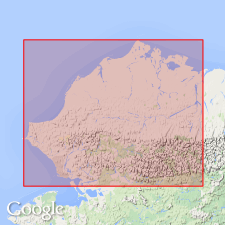
- Usage in publication:
-
- Sadlerochit sandstone*
- Modifications:
-
- Age modified
- AAPG geologic province:
-
- Alaska Northern region
Summary:
Correlation chart shows Sadlerochit sandstone of Canning River region as Permian age.
Source: GNU records (USGS DDS-6; Menlo GNULEX).
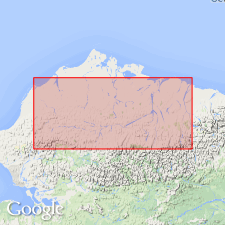
- Usage in publication:
-
- Sadlerochit sandstone*
- Modifications:
-
- Areal extent
- AAPG geologic province:
-
- Alaska Northern region
Summary:
Unit geographically extended westward as far as Sagavanirktok River.
Source: GNU records (USGS DDS-6; Menlo GNULEX).
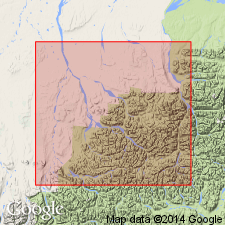
- Usage in publication:
-
- Sadlerochit formation*
- Modifications:
-
- Redescribed
- Revised
- Age modified
- Dominant lithology:
-
- Sandstone
- Siltstone
- Limestone
- Shale
- AAPG geologic province:
-
- Alaska Northern region
Summary:
Presumably type locality is south side of Sadlerochit Mountains for Sadlerochit sandstone of Leffingwell (1919) which is here referred to as Sadlerochit formation since rocks which lie stratigraphically between Lisburne group and Shublik formation include siltstone, shale, limestone, and chert in addition to sandstone. Divided into (ascending): Echooka (of Permian age) and Ivishak (of Early Triassic age) members (both new). Seven stratigraphic measured sections of unit, lists of fossils, and geologic map of Shaviovik and Sagavanirktok Rivers area included in report.
Source: GNU records (USGS DDS-6; Menlo GNULEX).
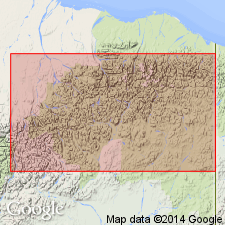
- Usage in publication:
-
- Sadlerochit Formation*
- Modifications:
-
- Areal extent
- AAPG geologic province:
-
- Alaska Northern region
Summary:
Sadlerochit Formation geographically extended eastward to Kongakut River-Joe Creek area as shown in correlation chart. Unconformably overlies Wahoo Limestone of Lisburne Group at most places but at Wahoo Lake contact appears gradational.
Source: GNU records (USGS DDS-6; Menlo GNULEX).
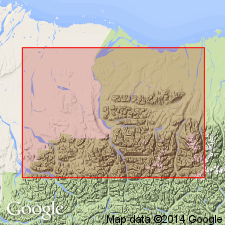
- Usage in publication:
-
- Sadlerochit Formation*
- Modifications:
-
- Age modified
- Biostratigraphic dating
- AAPG geologic province:
-
- Alaska Northern region
Summary:
Brachiopod assemblage from lower part of Echooka Member is equivalent to early Kazanian of earliest Late Permian age. Upper part of member contains assemblage of slightly younger Late Permian age. [Thus age of Sadlerochit is Late Permian and Early Triassic].
Source: GNU records (USGS DDS-6; Menlo GNULEX).
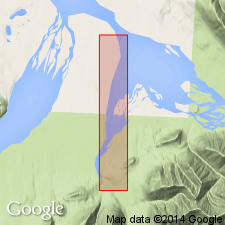
- Usage in publication:
-
- Sadlerochit Formation*
- Modifications:
-
- Age modified
- Biostratigraphic dating
- AAPG geologic province:
-
- Alaska Northern region
Summary:
Late Early Permian age for part of Sadlerochit Formation is substantiated by brachiopod fauna including ATTENUATELLA sp. and ANIDANTHUS sp. found on Flood Creek in Sagavanirktok quad. [Thus age of Sadlerochit is late Early Permian, Late Permian, and Early Triassic].
Source: GNU records (USGS DDS-6; Menlo GNULEX).
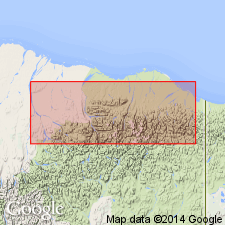
- Usage in publication:
-
- Sadlerochit Group*
- Modifications:
-
- Revised
- AAPG geologic province:
-
- Alaska Northern region
Summary:
Sadlerochit Formation is raised in rank to Sadlerochit Group. Type locality designated as south slope of Sadlerochit Mountains, immediately north of mesa near east end of Ignek Valley [T3N R26E, Mt. Michelson quad]. Echooka and Ivishak Members are raised in rank to Echooka and Ivishak Formations (of Sadlerochit Group) in order to permit further subdivision. Echooka is divided into (ascending): Joe Creek and Ikiakpaurak Members (both new). Ivishak Formation is divided into (ascending): Kavik, Ledge Sandstone, and Fire Creek Siltstone Members (all new). Age of Sadlerochit Group remains late Early Permian (Artinskian), Late Permian, and Early Triassic as shown in correlation chart.
Source: GNU records (USGS DDS-6; Menlo GNULEX).
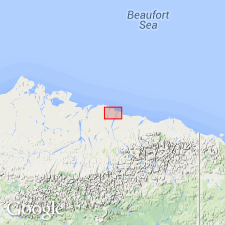
- Usage in publication:
-
- Sadlerochit Group
- Modifications:
-
- Revised
- Biostratigraphic dating
- AAPG geologic province:
-
- Alaska Northern region
Summary:
Sadlerochit Group in subsurface of Prudhoe Bay area is subdivided into (ascending): Echooka Formation (mid-Permian), Kavik Shale (Late Permian), and Ivishak Sandstone (Late Permian to Early Triassic). Echooka Formation is probably equivalent to Ikiakpaurak Member of Echooka Formation of Detterman and others (1975). Kavik Shale is equivalent to Kavik Member of Ivishak Formation of Detterman and others (1975). Ivishak Sandstone is equivalent to Ledge Sandstone Member of Ivishak Formation of Detterman and others (1975). In Eileen area, an interval of siltstone (correlated by Alaska Geological Society, 1970-1971 with "Ivishak Member" in Colville No.1 well) is included in Shublik Formation in this report, although interval may prove to be equivalent to Fire Creek Siltstone Member of Ivishak Formation of Detterman and others (1975) [and could be raised in rank]. Age of Sadlerochit Group is tentatively assigned as mid-Permian to Early Triassic based on microfloral assemblages.
Source: GNU records (USGS DDS-6; Menlo GNULEX).
For more information, please contact Nancy Stamm, Geologic Names Committee Secretary.
Asterisk (*) indicates published by U.S. Geological Survey authors.
"No current usage" (†) implies that a name has been abandoned or has fallen into disuse. Former usage and, if known, replacement name given in parentheses ( ).
Slash (/) indicates name conflicts with nomenclatural guidelines (CSN, 1933; ACSN, 1961, 1970; NACSN, 1983, 2005, 2021). May be explained within brackets ([ ]).

